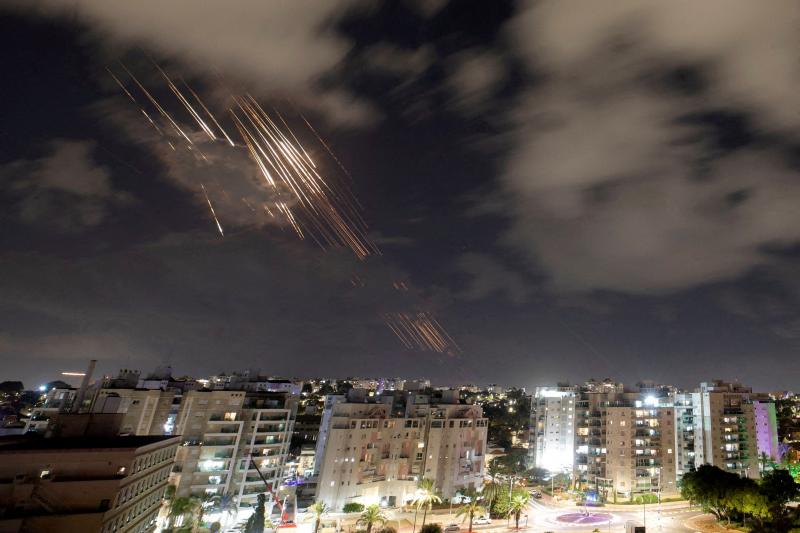Iran's missile barrage this month against Israel, after a similar large-scale attack in April, shows the value, as well as the shortcomings, of US and allied missile defenses in a potential Indo-Pacific conflict with China, analysts say.
Although differences between the two scenarios limit the lessons that can be learned, the nearly 400 missiles of different types that Iran has fired at Israel this year offer the US and China some idea of what works and what does not.
For Washington, the main takeaway from Iran's Oct. 1 attacks — the largest sample yet of ballistic missiles fired against modern defenses — could be that Beijing's missiles would be more difficult to intercept than Iran's and that the ability to strike back would be needed to deter a mass attack, said Collin Koh of the S. Rajaratnam School of International Studies in Singapore.

Photo: Reuters
"If we look purely through the lenses of deterrence, no longer can one pin hopes on deterrence by denial only — that is, the hope that effective defenses can blunt the efficacy of missile strikes," Koh said. "Deterrence by punishment might have to become normative going forward."
There is no immediate threat of missile conflict in the Indo-Pacific region. The distances, thousands of kilometers, are greater than in the Middle East.
China's weapons are more advanced, including maneuvering warheads and precision guidance. Also, the target areas are scattered across the region, making a massed attack more difficult.
China's military launched a new round of war games near Taiwan today, saying it was a warning to the "separatist acts of Taiwan independence forces."
A Taiwan security source said there were no signs so far of any missile launches.
The US has developed and deployed new weapons in the region this year to counter China, including the AIM-174B air-to-air missile and the ground-based Typhon missile battery in the Philippines, which can launch SM-6 and Tomahawk missiles.
The US Indo-Pacific Command and Chinese Ministry of Defense did not immediately respond to requests for comment.
On the other hand, simply being better informed about how offensive and defensive systems perform after Iran's missile fusillades — many were intercepted — may reduce the chance of conflict, Ankit Panda of the US-based Carnegie Endowment for International Peace said.
"Any military force planning long-range missile strikes will need to plan around the possible effects of missile defenses," Panda said. "Of course, without clarity on how well a given missile defense system might perform, this could lead to massive escalation."
Israel's layered air and missile defenses — from its long-range Arrow systems to the Iron Dome shield meant to handle slower, less complex threats — are tailored to the threats it faces: guided ballistic missiles from powers such as Iran mixed with unguided rockets launched from just over Israel's borders.
The picture is much different in the Indo-Pacific region for the US and its allies, which use the Lockheed Martin, opens new tab and Raytheon, opens new tab Patriot, Terminal High Altitude Area Defense and sea-based Aegis systems for missile defense.
The accuracy of China's DF-26, its most numerous conventional intermediate-range ballistic missile, is estimated to be as good as 150m, according to the Center for Strategic and International Studies' Missile Defense Project.
Its DF-21 is shorter-ranged, although some variants have an accuracy of 50m.
Both can hit most US and allied targets in the region. The DF-26 can reach Guam, the site of major US military facilities.
The Pentagon has estimated that China may have several hundred of the missiles.
By contrast, Iran's missiles such as the Fattah-1 are theoretically more accurate — within 10s of meters — but are much shorter-ranged.
The number of these newer missiles is not public, but US Air Force General Kenneth McKenzie told Congress last year that Iran had more than 3,000 ballistic missiles of all types.
China's capabilities outstrip Iran's in other ways, said Malcolm Davis, a senior analyst at the Australian Strategic Policy Institute.
Missile attacks would most likely be coordinated with anti-satellite strikes and cyberwarfare, both designed to complicate defense.
"Western [integrated air and missile defense] systems in the Indo-Pacific would have a much tougher time defeating a large Chinese missile strike, comprising hundreds or even thousands of missiles, compared to what the Iranians are capable of," Davis said.

Australia has announced an agreement with the tiny Pacific nation Nauru enabling it to send hundreds of immigrants to the barren island. The deal affects more than 220 immigrants in Australia, including some convicted of serious crimes. Australian Minister of Home Affairs Tony Burke signed the memorandum of understanding on a visit to Nauru, the government said in a statement on Friday. “It contains undertakings for the proper treatment and long-term residence of people who have no legal right to stay in Australia, to be received in Nauru,” it said. “Australia will provide funding to underpin this arrangement and support Nauru’s long-term economic

‘NEO-NAZIS’: A minister described the rally as ‘spreading hate’ and ‘dividing our communities,’ adding that it had been organized and promoted by far-right groups Thousands of Australians joined anti-immigration rallies across the country yesterday that the center-left government condemned, saying they sought to spread hate and were linked to neo-Nazis. “March for Australia” rallies against immigration were held in Sydney, and other state capitals and regional centers, according to the group’s Web site. “Mass migration has torn at the bonds that held our communities together,” the Web site said. The group posted on X on Saturday that the rallies aimed to do “what the mainstream politicians never have the courage to do: demand an end to mass immigration.” The group also said it was concerned about culture,

ANGER: Unrest worsened after a taxi driver was killed by a police vehicle on Thursday, as protesters set alight government buildings across the nation Protests worsened overnight across major cities of Indonesia, far beyond the capital, Jakarta, as demonstrators defied Indonesian President Prabowo Subianto’s call for calm. The most serious unrest was seen in the eastern city of Makassar, while protests also unfolded in Bandung, Surabaya, Solo and Yogyakarta. By yesterday morning, crowds had dispersed in Jakarta. Troops patrolled the streets with tactical vehicles and helped civilians clear trash, although smoke was still rising in various protest sites. Three people died and five were injured in Makassar when protesters set fire to the regional parliament building during a plenary session on Friday evening, according to

STILL AFLOAT: Satellite images show that a Chinese ship damaged in a collision earlier this month was under repair on Hainan, but Beijing has not commented on the incident Australia, Canada and the Philippines on Wednesday deployed three warships and aircraft for drills against simulated aerial threats off a disputed South China Sea shoal where Chinese forces have used risky maneuvers to try to drive away Manila’s aircraft and ships. The Philippine military said the naval drills east of Scarborough Shoal (Huangyan Island, 黃岩島) were concluded safely, and it did not mention any encounter with China’s coast guard, navy or suspected militia ships, which have been closely guarding the uninhabited fishing atoll off northwestern Philippines for years. Chinese officials did not immediately issue any comment on the naval drills, but they